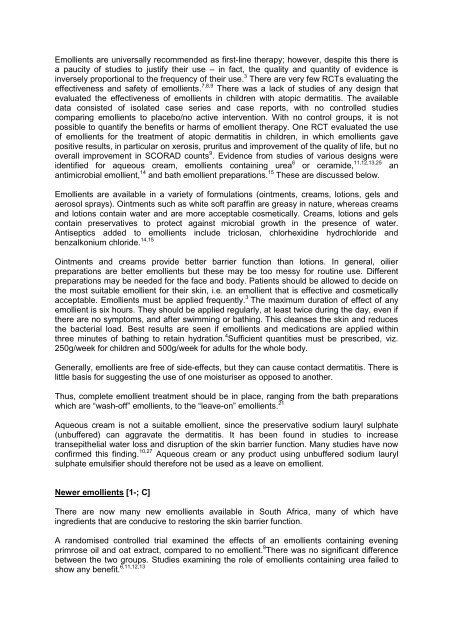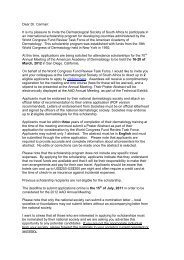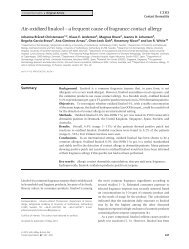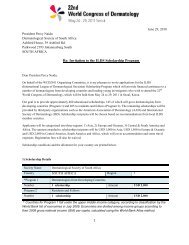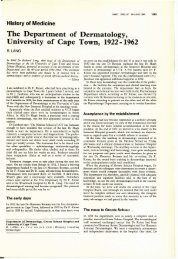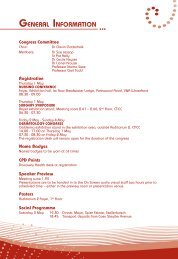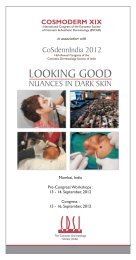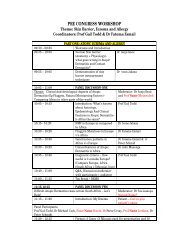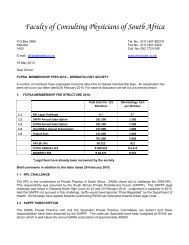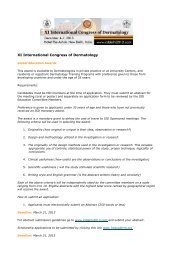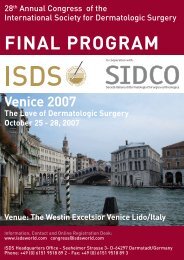Guidelines on the Management of Atopic Dermatitis ... - Dermatology
Guidelines on the Management of Atopic Dermatitis ... - Dermatology
Guidelines on the Management of Atopic Dermatitis ... - Dermatology
You also want an ePaper? Increase the reach of your titles
YUMPU automatically turns print PDFs into web optimized ePapers that Google loves.
Emollients are universally recommended as first-line <strong>the</strong>rapy; however, despite this <strong>the</strong>re is<br />
a paucity <strong>of</strong> studies to justify <strong>the</strong>ir use – in fact, <strong>the</strong> quality and quantity <strong>of</strong> evidence is<br />
inversely proporti<strong>on</strong>al to <strong>the</strong> frequency <strong>of</strong> <strong>the</strong>ir use. 3 There are very few RCTs evaluating <strong>the</strong><br />
effectiveness and safety <strong>of</strong> emollients. 7,8,9 There was a lack <strong>of</strong> studies <strong>of</strong> any design that<br />
evaluated <strong>the</strong> effectiveness <strong>of</strong> emollients in children with atopic dermatitis. The available<br />
data c<strong>on</strong>sisted <strong>of</strong> isolated case series and case reports, with no c<strong>on</strong>trolled studies<br />
comparing emollients to placebo/no active interventi<strong>on</strong>. With no c<strong>on</strong>trol groups, it is not<br />
possible to quantify <strong>the</strong> benefits or harms <strong>of</strong> emollient <strong>the</strong>rapy. One RCT evaluated <strong>the</strong> use<br />
<strong>of</strong> emollients for <strong>the</strong> treatment <strong>of</strong> atopic dermatitis in children, in which emollients gave<br />
positive results, in particular <strong>on</strong> xerosis, pruritus and improvement <strong>of</strong> <strong>the</strong> quality <strong>of</strong> life, but no<br />
overall improvement in SCORAD counts 9 . Evidence from studies <strong>of</strong> various designs were<br />
identified for aqueous cream, emollients c<strong>on</strong>taining urea 6 or ceramide, 11,12,13,25 an<br />
antimicrobial emollient, 14 and bath emollient preparati<strong>on</strong>s. 15 These are discussed below.<br />
Emollients are available in a variety <strong>of</strong> formulati<strong>on</strong>s (ointments, creams, loti<strong>on</strong>s, gels and<br />
aerosol sprays). Ointments such as white s<strong>of</strong>t paraffin are greasy in nature, whereas creams<br />
and loti<strong>on</strong>s c<strong>on</strong>tain water and are more acceptable cosmetically. Creams, loti<strong>on</strong>s and gels<br />
c<strong>on</strong>tain preservatives to protect against microbial growth in <strong>the</strong> presence <strong>of</strong> water.<br />
Antiseptics added to emollients include triclosan, chlorhexidine hydrochloride and<br />
benzalk<strong>on</strong>ium chloride. 14,15<br />
Ointments and creams provide better barrier functi<strong>on</strong> than loti<strong>on</strong>s. In general, oilier<br />
preparati<strong>on</strong>s are better emollients but <strong>the</strong>se may be too messy for routine use. Different<br />
preparati<strong>on</strong>s may be needed for <strong>the</strong> face and body. Patients should be allowed to decide <strong>on</strong><br />
<strong>the</strong> most suitable emollient for <strong>the</strong>ir skin, i.e. an emollient that is effective and cosmetically<br />
acceptable. Emollients must be applied frequently. 3 The maximum durati<strong>on</strong> <strong>of</strong> effect <strong>of</strong> any<br />
emollient is six hours. They should be applied regularly, at least twice during <strong>the</strong> day, even if<br />
<strong>the</strong>re are no symptoms, and after swimming or bathing. This cleanses <strong>the</strong> skin and reduces<br />
<strong>the</strong> bacterial load. Best results are seen if emollients and medicati<strong>on</strong>s are applied within<br />
three minutes <strong>of</strong> bathing to retain hydrati<strong>on</strong>. 4 Sufficient quantities must be prescribed, viz.<br />
250g/week for children and 500g/week for adults for <strong>the</strong> whole body.<br />
Generally, emollients are free <strong>of</strong> side-effects, but <strong>the</strong>y can cause c<strong>on</strong>tact dermatitis. There is<br />
little basis for suggesting <strong>the</strong> use <strong>of</strong> <strong>on</strong>e moisturiser as opposed to ano<strong>the</strong>r.<br />
Thus, complete emollient treatment should be in place, ranging from <strong>the</strong> bath preparati<strong>on</strong>s<br />
which are “wash-<strong>of</strong>f” emollients, to <strong>the</strong> “leave-<strong>on</strong>” emollients. 21<br />
Aqueous cream is not a suitable emollient, since <strong>the</strong> preservative sodium lauryl sulphate<br />
(unbuffered) can aggravate <strong>the</strong> dermatitis. It has been found in studies to increase<br />
transepi<strong>the</strong>lial water loss and disrupti<strong>on</strong> <strong>of</strong> <strong>the</strong> skin barrier functi<strong>on</strong>. Many studies have now<br />
c<strong>on</strong>firmed this finding. 10,27 Aqueous cream or any product using unbuffered sodium lauryl<br />
sulphate emulsifier should <strong>the</strong>refore not be used as a leave <strong>on</strong> emollient.<br />
Newer emollients [1-; C]<br />
There are now many new emollients available in South Africa, many <strong>of</strong> which have<br />
ingredients that are c<strong>on</strong>ducive to restoring <strong>the</strong> skin barrier functi<strong>on</strong>.<br />
A randomised c<strong>on</strong>trolled trial examined <strong>the</strong> effects <strong>of</strong> an emollients c<strong>on</strong>taining evening<br />
primrose oil and oat extract, compared to no emollient. 9 There was no significant difference<br />
between <strong>the</strong> two groups. Studies examining <strong>the</strong> role <strong>of</strong> emollients c<strong>on</strong>taining urea failed to<br />
show any benefit. 6,11,12,13


